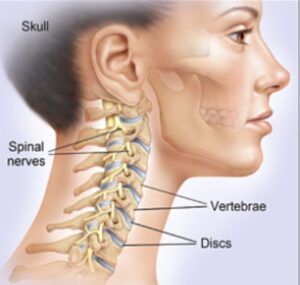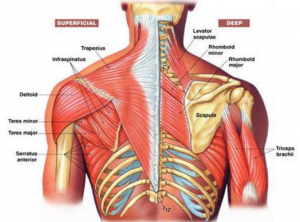What is causing my neck pain and headache?

 Headaches that originate from structures of the neck are called cervicogenic headaches, they are very common and account for up to 20% of all reported headaches (1). Often, a person suffering a cervicogenic headache will also have neck pain or stiffness, but this is not always the case. If the headache is caused by structures in the neck, then the pain is usually on one side of the head and mainly around the base of the skull, the orbit of the eye, and the forehead (2). People who suffer from cervicogenic headaches will usually have some stiffness in the neck, or difficulty moving the head in one or more directions (3).
Headaches that originate from structures of the neck are called cervicogenic headaches, they are very common and account for up to 20% of all reported headaches (1). Often, a person suffering a cervicogenic headache will also have neck pain or stiffness, but this is not always the case. If the headache is caused by structures in the neck, then the pain is usually on one side of the head and mainly around the base of the skull, the orbit of the eye, and the forehead (2). People who suffer from cervicogenic headaches will usually have some stiffness in the neck, or difficulty moving the head in one or more directions (3).
 There are several structures in the neck that can be the cause of headaches, these include the muscles, joints, neck discs, nerves, and blood vessels. The one thing all the headache-causing structures in the neck share is that their nerve supply is from the top three exiting nerves from the neck. (IMAGE). It is thought that the reason that these structures can cause pain in the head and face is that their nerve supply interacts with another structure called the trigeminal nerve that senses pain in the face and head (4).
There are several structures in the neck that can be the cause of headaches, these include the muscles, joints, neck discs, nerves, and blood vessels. The one thing all the headache-causing structures in the neck share is that their nerve supply is from the top three exiting nerves from the neck. (IMAGE). It is thought that the reason that these structures can cause pain in the head and face is that their nerve supply interacts with another structure called the trigeminal nerve that senses pain in the face and head (4).
There are various structures of the upper neck that can cause headaches, these are;
Atalanto-Occipital Joint
This is the very top joint of the neck, adjacent to the skull. This joint primarily lets you perform a nodding action. Either the joint on one side can be limited in its movement, or it can be both joints at that level. 
Atlanto-Axial Joint
This is the second joint down in the neck. This joint is responsible for over half of the rotation movement in the neck and seventy percent of sufferers of cervicogenic headaches have been found to have a movement dysfunction in this joint (5).
The Sub-Occipital Muscles
These are a small set of muscles that move the two joints described above, often they can have sensitive areas in them that can refer pain into the head (6).
The Upper Trapezius
The trapezius muscle is a very large superficial muscle that starts at the base of the skull, spreads out to the top of the shoulder and then stretches down to the mid back. The upper portions of it play a large role in the movement of the shoulder blade and people with cervicogenic headaches tend to  show differences in tone and tightness in this part of the muscle when compared to people who do not suffer from headaches (7). These differences can be due to postural issues, weakness of some of the other scapular stabilisers, or a lack of movement in the neck joints (3).
show differences in tone and tightness in this part of the muscle when compared to people who do not suffer from headaches (7). These differences can be due to postural issues, weakness of some of the other scapular stabilisers, or a lack of movement in the neck joints (3).
Muscles in the Front of the Neck
Postural issues can also lead to tightness and weakness in some of the muscles in the front of the neck, the postural pattern most associated with these types of issues is ‘upper cross syndrome’. Upper cross syndrome is what the technical term is for being round-shouldered, this pattern makes the muscles on the front of the upper body tight and/or weak. More specifically tightness and areas of dysfunction in a muscle called sternocleidomastoid can refer pain to the head and face in a very similar pattern to that of a cervicogenic headache (8). The other common finding in people with cervicogenic headaches is weakness in the deep muscles of the neck that flex the head forwards (9).
How Can I Find Out What is Causing My Headache?
Given the range of neck structures that may be causing a person’s headache, to get rid of the pain it is vital to first know what is the structure or circumstances that is generating the problem. To do this your osteopath can perform a thorough examination of all the structures listed above, including how each joint moves, which muscles are tight, and which may be weak. As well as this they can take a full history of your problem to see if there is anything you may be doing that may be helping cause a headache.
circumstances that is generating the problem. To do this your osteopath can perform a thorough examination of all the structures listed above, including how each joint moves, which muscles are tight, and which may be weak. As well as this they can take a full history of your problem to see if there is anything you may be doing that may be helping cause a headache.
What is the Best Way to Get Rid of my Headache?
We find that effective treatment for cervicogenic headaches needs to be multi-modal but most commonly involves mobilization of the joints of the upper neck, massage-like techniques to any of the muscles that we find are referring pain to the head, and carefully prescribed exercises to help strengthen or stretch areas that have become dysfunctional and are producing pain. One other intervention that we commonly use is to advise people on their workstation setup as (especially since the advent of homeworking) their setup is commonly a cause of neck and head pain.
Do you want to know what is causing your pain and if we can help? Why not take advantage of our new patient assessment introductory offer to get you started towards a tailor made recovery plan for only £19.
Are you in a lot of pain and want to get better as soon as possible? If so then why not book in for a new patient consultation, with treatment on the day, for £75.
References –
1 – Fernandez M, Moore C, Tan J, Lian D, Nguyen J, Bacon A et al. Spinal manipulation for the management of cervicogenic headache: A systematic review and meta‐analysis. Eur J Pain. 2020; 24(9): 1687-702.
2 – Uthaikhup S, Barbero M, Falla D, Sremakaew M, Tanrprawate S, Nudsasarn A. Profiling the Extent and Location of Pain in Migraine and Cervicogenic Headache: A Cross-sectional Single-Site Observational Study. Pain Med. 2020 Sep 11:pnaa282.
3 – Kaplan A. Introduction to Cervicogenic Headache Course. Plus , 2020.
4 – Biondi DM. Cervicogenic headache: mechanisms, evaluation, and treatment strategies. J Am Osteopath Assoc. 2000;100(9 Suppl): S7-14.
5 – Rubio-Ochoa J, Benítez-Martínez J, Lluch E, Santacruz-Zaragozá S, Gómez-Contreras P, Cook CE. Physical examination tests for screening and diagnosis of cervicogenic headache: A systematic review. Man Ther. 2016; 21: 35-40.
6 – Goodman, C, Fuller, K. Pathology: Implications for the Physical Therapist. 3rd ed. St. Louis: Saunders Elsevier, 2009.
7 – Park SK, Yang DJ, Kim JH, Heo JW, Uhm YH, Yoon JH. Analysis of mechanical properties of cervical muscles in patients with cervicogenic headache. J Phys Ther Sci. 2017; 29(2): 332-335.
8 – Cook S, Moule AJ, Diagnosing Pain Referral from Neck and Shoulders. In: Moule AJ, Hicks ML, editors. Diagnosing Dental and Orofacial Pain: A Clinical Manual. Chichester: John Wiley & Sons, Ltd, 2016. p89-95.
9 – Page P. Cervicogenic headaches: an evidence-led approach to clinical management. Int J Sports Phys Ther. 2011; 6(3): 254-66.
